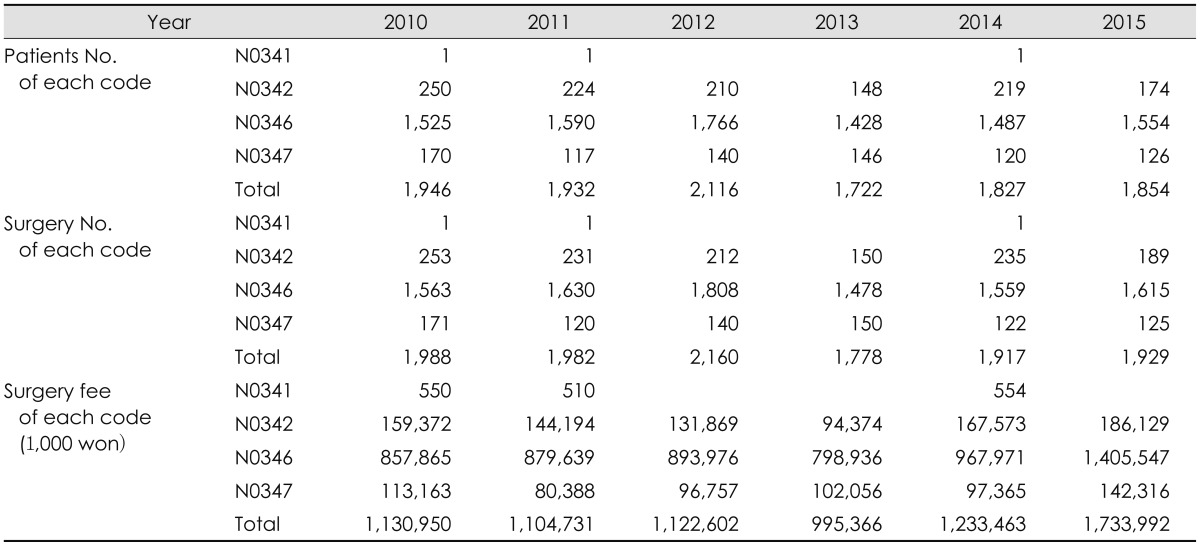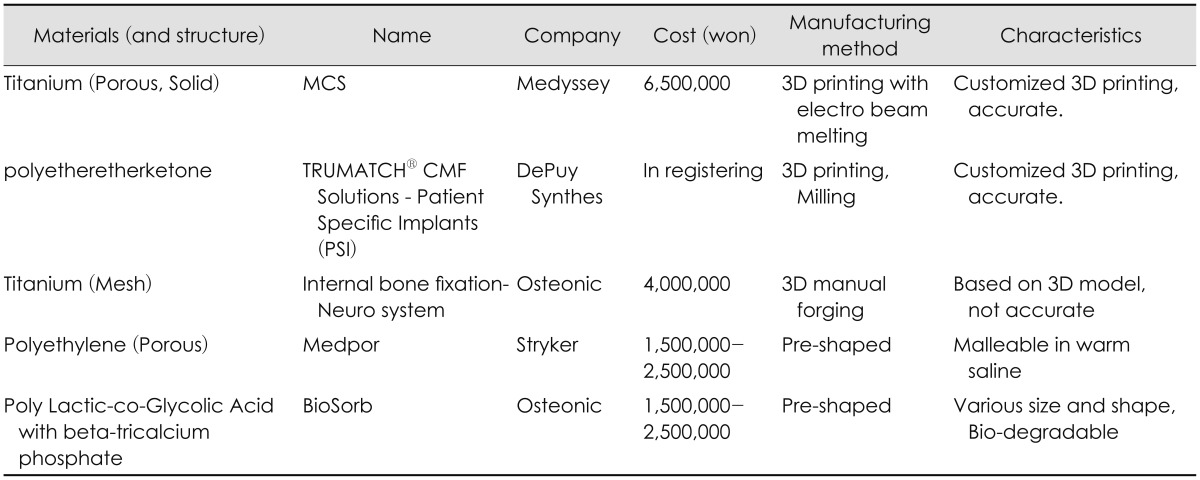1. Abbott KH. Use of frozen cranial bone flaps for autogenous and homologous grafts in cranioplasty and spinal interbody fusion. J Neurosurg. 1953; 10:380–388. PMID:
13070062.
2. Acciarri N, Palandri G, Cuoci A, Valluzzi A, Lanzino G. Cranioplasty in neurosurgery: is there a way to reduce complications? J Neurosurg Sci. [epub ahead of print, 2016.].

3. Arun Kumar KV, Singla NK, Gowda ME, Kumar D, Legha VS. Current Concepts in Restoring Acquired Cranial Defects. J Indian Prosthodont Soc. 2014; 14:14–17. PMID:
26199486.

4. Asano Y, Ryuke Y, Hasuo M, Simosawa S. Cranioplasty using cryopreserved autogenous bone. No To Shinkei. 1993; 45:1145–1150. PMID:
8123304.
5. Barthélemy EJ, Melis M, Gordon E, Ullman JS, Germano IM. Decompressive craniectomy for severe traumatic brain Injury: A systematic review. World Neurosurg. 2016; 88:411–420. PMID:
26732949.

6. Bhaskar IP, Inglis TJ, Lee GY. Clinical, radiological, and microbiological profile of patients with autogenous cranioplasty infections. World Neurosurg. 2014; 82:e531–e534. PMID:
23298668.

7. Bhaskar IP, Yusheng L, Zheng M, Lee GY. Autogenous skull flaps stored frozen for more than 6 months: do they remain viable? J Clin Neurosci. 2011; 18:1690–1693. PMID:
22000837.

8. Bhaskar IP, Zaw NN, Zheng M, Lee GY. Bone flap storage following craniectomy: a survey of practices in major Australian neurosurgical centres. ANZ J Surg. 2011; 81:137–141. PMID:
21342384.

9. Bonda DJ, Manjila S, Selman WR, Dean D. The recent revolution in the design and manufacture of cranial implants: modern advancements and future directions. Neurosurgery. 2015; 77:814–824. PMID:
26171578.
10. Brommeland T, Rydning PN, Pripp AH, Helseth E. Cranioplasty complications and risk factors associated with bone flap resorption. Scand J Trauma Resusc Emerg Med. 2015; 23:75. PMID:
26437934.

11. Carvi Y, Nievas MN, Höllerhage HG. Early combined cranioplasty and programmable shunt in patients with skull bone defects and CSF-circulation disorders. Neurol Res. 2006; 28:139–144. PMID:
16551430.
12. Chaturvedi J, Botta R, Prabhuraj AR, Shukla D, Bhat DI, Devi BI. Complications of cranioplasty after decompressive craniectomy for traumatic brain injury. Br J Neurosurg. 2016; 30:264–268. PMID:
26083136.

13. Chiang HY, Steelman VM, Pottinger JM, Schlueter AJ, Diekema DJ, Greenlee JD, et al. Clinical significance of positive cranial bone flap cultures and associated risk of surgical site infection after craniotomies or craniectomies. J Neurosurg. 2011; 114:1746–1754. PMID:
21375380.

14. Chun HJ, Yi HJ. Efficacy and safety of early cranioplasty, at least within 1 month. J Craniofac Surg. 2011; 22:203–207. PMID:
21233757.

15. Clune JE, Mulliken JB, Glowacki J, Arany PR, Kulungowski AM, Rogers GF, et al. Autologous cranial particulate bone graft: an experimental study of onlay cranioplasty. J Craniofac Surg. 2011; 22:319–323. PMID:
21239926.
16. Elliott H, Scott HJ. The bone-bank in neurosurgery. Br J Surg. 1951; 39:31–34. PMID:
14858821.

17. Erdogan E, Duz B, Kocaoglu M, Izci Y, Sirin S, Timurkaynak E. The effect of cranioplasty on cerebral hemodynamics: evaluation with transcranial Doppler sonography. Neurol India. 2003; 51:479–481. PMID:
14742926.
18. Fukuta K, Har-Shai Y, Collares MV, Herschman BR, Persiani RJ, Jackson IT. The viability of revascularized calvarial bone graft in a pig model. Ann Plast Surg. 1992; 29:136–142. PMID:
1530263.

19. Georgiou K, Fan C, Ng Y, Shandala T, King T, Scherer M, et al. Do cryopreserved autogenous cranial bone flaps remain viable at cranioplasty? Bone. 2010; 47:S387–S388.

20. Gilardino MS, Karunanayake M, Al-Humsi T, Izadpanah A, Al-Ajmi H, Marcoux J, et al. A comparison and cost analysis of cranioplasty techniques: autologous bone versus custom computer-generated implants. J Craniofac Surg. 2015; 26:113–117. PMID:
25534061.
21. Gordon CR, Fisher M, Liauw J, Lina I, Puvanesarajah V, Susarla S, et al. Multidisciplinary approach for improved outcomes in secondary cranial reconstruction: introducing the pericranial-onlay cranioplasty technique. Neurosurgery. 2014; 10(Suppl 2):179–189. PMID:
24448187.

22. Griessenauer CJ, He L, Salem M, Chua M, Ogilvy CS, Thomas AJ. Epidural bovine pericardium facilitates dissection during cranioplasty: A technical note. World Neurosurg. 2015; 84:2059–2063. PMID:
26283487.

23. Hayward RD. Cranioplasty: don't forget the patient's own bone is cheaper than titanium. Br J Neurosurg. 1999; 13:490–491. PMID:
10627781.

24. Honeybul S, Morrison DA, Ho KM, Lind CR, Geelhoed E. A randomized controlled trial comparing autologous cranioplasty with custom-made titanium cranioplasty. J Neurosurg. 2017; 126:81–90. PMID:
26991387.

25. Ikeda H, Kurisu K, Kihira K. Vancomycin ointment for MRSA infection at a cranioplasty site. Ann Pharmacother. 2004; 38:70–72. PMID:
14742798.

26. Jho DH, Neckrysh S, Hardman J, Charbel FT, Amin-Hanjani S. Ethylene oxide gas sterilization: a simple technique for storing explanted skull bone. Technical note. J Neurosurg. 2007; 107:440–445. PMID:
17695404.
27. Joaquim AF, Mattos JP, Chaddad F, de Oliveira E. Bone flap management in neurosurgery. Rev Neurociências. 2009; 17:133–137.

28. Kaku M, Koseki H, Kojima S, Sumi H, Shikata H, Kojima S, et al. Cranial bone regeneration after cranioplasty using cryopreserved autogenous bone by a programmed freezer with a magnetic field in rats. Cryo Letters. 2014; 35:451–461. PMID:
25583005.
29. Khader BA, Towler MR. Materials and techniques used in cranioplasty fixation: A review. Mater Sci Eng C Mater Biol Appl. 2016; 66:315–322. PMID:
27207068.

30. Kim H, Sung SO, Kim SJ, Kim SR, Park IS, Jo KW. Analysis of the factors affecting graft infection after cranioplasty. Acta Neurochir (Wien). 2013; 155:2171–2176. PMID:
24043415.

31. Kuleshova LL, Gouk SS, Hutmacher DW. Vitrification as a prospect for cryopreservation of tissue-engineered constructs. Biomaterials. 2007; 28:1585–1596. PMID:
17178158.

32. Lee BS, Min KS, Lee MS, Kim YG, Kim DH. Comparison with subcutaneous abdominal preservation and cryoconservation using autologous bone flap after decompressive craniectomy. Korean J Neurotrauma. 2012; 8:21–25.

33. Lee SH, Yoo CJ, Lee U, Park CW, Lee SG, Kim WK. Resorption of autogenous bone graft in cranioplasty: Resorption and reintegration failure. Korean J Neurotrauma. 2014; 10:10–14. PMID:
27169026.

34. Lemée JM, Petit D, Splingard M, Menei P. Autologous bone flap versus hydroxyapatite prosthesis in first intention in secondary cranioplasty after decompressive craniectomy: a French medico-economical study. Neurochirurgie. 2013; 59:60–63. PMID:
23414773.

35. Lethaus B, Bloebaum M, Koper D, Poort-Ter Laak M, Kessler P. Interval cranioplasty with patient-specific implants and autogenous bone grafts--success and cost analysis. J Craniomaxillofac Surg. 2014; 42:1948–1951. PMID:
25443869.
36. Liang W, Xiaofeng Y, Weiguo L, Gang S, Xuesheng Z, Fei C, et al. Cranioplasty of large cranial defect at an early stage after decompressive craniectomy performed for severe head trauma. J Craniofac Surg. 2007; 18:526–532. PMID:
17538313.

37. Malcolm JG, Rindler RS, Chu JK, Grossberg JA, Pradilla G, Ahmad FU. Complications following cranioplasty and relationship to timing: A systematic review and meta-analysis. J Clin Neurosci. 2016; 33:39–51. PMID:
27499122.

38. Osawa M, Hara H, Ichinose Y, Koyama T, Kobayashi S, Sugita Y. Cranioplasty with a frozen and autoclaved bone flap. Acta Neurochir (Wien). 1990; 102:38–41. PMID:
2305650.

39. Piitulainen JM, Kauko T, Aitasalo KM, Vuorinen V, Vallittu PK, Posti JP. Outcomes of cranioplasty with synthetic materials and autologous bone grafts. World Neurosurg. 2015; 83:708–714. PMID:
25681593.

40. Plum AW, Tatum SA. A comparison between autograft alone, bone cement, and demineralized bone matrix in cranioplasty. Laryngoscope. 2015; 125:1322–1327. PMID:
25641743.

41. Prolo DJ, Burres KP, McLaughlin WT, Christensen AH. Autogenous skull cranioplasty: fresh and preserved (frozen), with consideration of the cellular response. Neurosurgery. 1979; 4:18–29. PMID:
450211.
42. Quah BL, Low HL, Wilson MH, Bimpis A, Nga VD, Lwin S, et al. Is there an optimal time for performing cranioplasties? Results from a prospective multinational study. World Neurosurg. 2016; 94:13–17. PMID:
27368511.

43. Rish BL, Dillon JD, Meirowsky AM, Caveness WF, Mohr JP, Kistler JP, et al. Cranioplasty: a review of 1030 cases of penetrating head injury. Neurosurgery. 1979; 4:381–385. PMID:
111153.
44. Ronderos JF, Wiles DA, Ragan FA, Dempesy CW, Culicchia FC, Fontana CJ, et al. Cranioplasty using gentamicin-loaded acrylic cement: a test of neurotoxicity. Surg Neurol. 1992; 37:356–360. PMID:
1631760.

45. Shaffrey ME, Persing JA, Shaffrey CI. Craniofacial reconstruction. In : Apuzzo MLJ, editor. Brain surgery: Complication avoidance and management. New York, NY: Churchill Livingstone;1993. p. 1373–1398.
46. Son S, Park CW, Kim EY, Kim JM, Yoo CJ. Bone resorption of autologous cranioplasty following decompressive craniectomy in children: case report. J Korean Neurotraumatol Soc. 2009; 5:118–123.
47. Songara A, Gupta R, Jain N, Rege S, Masand R. Early cranioplasty in patients with posttraumatic decompressive craniectomy and its correlation with changes in cerebral perfusion parameters and neurocognitive outcome. World Neurosurg. 2016; 94:303–308. PMID:
27418533.

48. Stefini R, Zanotti B, Nataloni A, Martinetti R, Scafuto M, Colasurdo M, et al. The efficacy of custom-made porous hydroxyapatite prostheses for cranioplasty: evaluation of postmarketing data on 2697 patients. J Appl Biomater Funct Mater. 2015; 13:e136–e144. PMID:
25589160.
49. Sundseth J, Sundseth A, Berg-Johnsen J, Sorteberg W, Lindegaard KF. Cranioplasty with autologous cryopreserved bone after decompressive craniectomy: complications and risk factors for developing surgical site infection. Acta Neurochir (Wien). 2014; 156:805–811. PMID:
24493001.

50. Takeuchi H, Higashino Y, Hosoda T, Yamada S, Arishima H, Kodera T, et al. Long-term follow-up of cryopreservation with glycerol of autologous bone flaps for cranioplasty after decompressive craniectomy. Acta Neurochir (Wien). 2016; 158:571–575. PMID:
26733129.

51. Tasiou A, Vagkopoulos K, Georgiadis I, Brotis AG, Gatos H, Fountas KN. Cranioplasty optimal timing in cases of decompressive craniectomy after severe head injury: a systematic literature review. Interdiscip Neurosurg. 2014; 1:107–111.

52. Teitelbaum SL. Bone resorption by osteoclasts. Science. 2000; 289:1504–1508. PMID:
10968780.

53. The Korean Neurosurgical Society. Neurosurgery. ed 4th. Seoul: The Korean Neurosurgical Society;2012.
54. Torimitsu S, Nishida Y, Takano T, Koizumi Y, Hayakawa M, Yajima D, et al. Effects of the freezing and thawing process on biomechanical properties of the human skull. Leg Med (Tokyo). 2014; 16:102–105. PMID:
24360926.

55. Worm PV, do Nascimento TL, do Couto Nicola F, Sanches EF, Dos Santos Moreira CF, Rogerio LP, et al. Polymethylmethacrylate imbedded with antibiotics cranioplasty: An infection solution for moderate and large defects reconstruction? Surg Neurol Int. 2016; 7:S746–S751. PMID:
27904754.

56. Xu H, Niu C, Fu X, Ding W, Ling S, Jiang X, et al. Early cranioplasty vs. late cranioplasty for the treatment of cranial defect: A systematic review. Clin Neurol Neurosurg. 2015; 136:33–40. PMID:
26056810.







 PDF
PDF ePub
ePub Citation
Citation Print
Print



 XML Download
XML Download